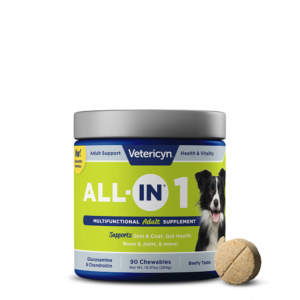Updated 6/25/2025
Much like humans, dog health and strength deteriorate with advancing age. Senior citizens and senior dogs alike struggle with mobility and may need more support to get up and around. However, just because mobility in senior dogs declines over time, doesn’t mean their quality of life has to too. If you notice your dog is slowing down with age, you will want to do everything you can to make their life easier and more comfortable.
Don’t worry, you don’t have to give up those joyous trips to the park or treasured evening strolls with your canine. Check out Vetericyn’s guide to senior dog mobility. We will explore the steps you can take to help keep your dog merry and moving in their old age.
Why Mobility Matters
Did you know that loss of mobility is one of the foremost causes of euthanasia? Unfortunately, many people aren’t aware of adjustments they can make to accommodate older dogs and opt to euthanize their beloved companions rather than see them slow down and suffer. But here’s a little secret: older dogs with mobility issues don’t have to be euthanized—there are things you can do to help them stay cozy, comfortable, and cheerful.
While it’s heartbreaking to watch your once agile pup that you blessed with the best puppy nutrition grow old and labor to get around, challenges in mobility aren’t necessarily a cause for despair. Senior dogs can and should still live fulfilling lives, even though they may have more difficulty moving. When given appropriate treatment and care, a dog with mobility issues can still live a comfortable, long life.
Making even the smallest changes to assist mobility in senior dogs can improve an animal’s overall wellness and lengthen its lifespan. A greater understanding of the kinds of mobility problems geriatric dogs experience and a willingness to make changes to address these problems can help your fluffy friend thrive during the golden years.
Is Your Dog Struggling with Mobility?
Giant breed dogs are considered to enter old age around 6-7 years, large and medium breeds around 8 to 10 years, and small or toy breeds around 8 to 11 years. They may begin to show signs of loss of mobility around this time. Before deciding what actions to take, you need to know what specific mobility issues your dog struggles with.
Signs and Symptoms
Being able to identify symptoms will help you find the most targeted solutions to your dog’s mobility issues. Here are some telltale signs of mobility problems in senior dogs to look out for:
- Walking slower or limping
- Struggling to sit and stand
- Slipping when getting up or walking around
- Exhibiting pain or stiffness
- Shifting weight onto front or back legs
- Favoring a limb
- Hesitating to engage in previously normal activities
- Showing trouble jumping and climbing

Common Causes of Mobility Issues
The above are indicators of a whole host of different mobility-related health issues in senior dogs. If you find your canine is exhibiting one or more of these symptoms, you may want to visit the doggy doctor. Getting a diagnosis from a vet can inform what kind of mobility aid your dog needs.
To better understand what your dog is experiencing, the following list describes some of the common causes of decreased mobility:
- Arthritis – Arthritis is one of the most common mobility issues faced by dogs across breeds. It’s a degenerative joint disease that causes inflammation and discomfort. Oftentimes, it’s a result of a lack of joint lubrication that slowly wears down cartilage. Over time, this may lead to bone friction and severe pain.
- Hip dysplasia – Hip health and strength are crucial to movement throughout a dog’s lifetime. However, hips are susceptible to developmental issues as well as over-exercise. A lack of attention to these sensitivities can lead to abnormal hip socket formation, known as dysplasia. This condition can impact mobility and cause bone and joint pain. Another important factor to note here is that hip dysplasia is highly correlated with genetics. Be sure to ask breeders or rescues about any history of hip dysplasia.
- Degenerative myelopathy—This disease of the spinal cord comes with old age. It tends to occur in a dog’s later years and is caused by nerve and spinal cord degeneration, which impacts coordination and limb strength. While not painful, progressive weakness in a dog’s rear and hind legs can hinder balance and present a handful of mobility obstacles.
- Cruciate ligament injury – This type of injury occurs when the cruciate ligament is partially torn or entirely ripped. Damage in this ligament between the femur and tibia affects a dog’s knees and can be crippling. Ease and range of mobility are limited during the healing process.
- Muscle atrophy – Atrophy is loss of muscle mass. It is often related to the onset of disease or reduced exercise in a dog’s later years. It is observed more in the hind legs than the front legs. When muscles atrophy, dogs have more trouble supporting themselves.
Other possible causes of loss of mobility include intervertebral disc disease, general bone degradation, and side effects from heart disease, digestive disorders, or systemic disease.
Treating Mobility in Senior Dogs
When it comes to mobility, vets and pet experts recommend that dog owners combine a variety of approaches for best results. While different conditions may at times require different treatments, there are a surprising number of simple accommodations that can help with symptoms of decreased mobility in senior dogs across the board.
A comprehensive treatment plan for senior dog mobility issues usually involves both at-home lifestyle changes and professional medical care.

How to Help: At-Home Solutions
Making small environmental changes and adjustments in everyday activities is often overlooked as a means of managing pain, providing comfort, and affording self-sufficiency to senior dogs.
However, if you’re not paying attention to your elderly dog’s daily needs, you may end up causing them even more physical stress. For example, neglectingnail trimming can have detrimental effects on mobility. The difference between comfort and discomfort can come down to seemingly small details.
Like regular nail trims, the following quick-fixes to everyday mobility obstacles are easy, low-cost, and highly effective. Simple solutions like these can help with senior dog mobility problems caused by a range of geriatric conditions:
Prevent Slipping and Sliding
Slick surfaces like laminate floors, tiles, and glossy wood lack traction, making household surfaces like these hard to grip, which may cause a dog to skid and stumble.
If your senior dog is slipping and sliding around, you may want to invest in one of the following:
- Rugs with non-slip rug pad – There are a variousoptions for different spatial needs, from big rugs to carpet tiles and rug runners.
- Paw grip socks – Little socks or booties with rubber soles create paw traction and can reduce slippage. They can be taken on and off.
- Toe grips – These rubber bands worn around a doggie’s nails also help them grip the floor and can stay on for weeks.
Helping Dogs Up
Many elderly dogs have trouble climbing and jumping. They may have more difficulty getting into cars, reaching couches and beds, or getting up the stairs. Making big leaps without the necessary strength and balance makes a dog more prone to injuries that exacerbate mobility problems.
Ramps, pet steps, or stair treads are great options for senior dogs. They offer a more gradual, safer way for dogs to reach elevated surfaces. With products like these, senior dogs also don’t have to be picked up, which allows them to remain independent and active.
Support Systems
Senior dogs often require support to manage pain and ensure stability. Whether resting, eating, or walking, they will likely need extra reinforcements to be comfortable.
- Sleep support—A dog experiencing physical stress and mobility problems shouldn’t have to lie on the cold, hard floor. Hard surfaces can aggravate inflammation, soreness, and aches and pains. Luckily, special foam beds and orthopedic cushions provide senior dogs with a place to lounge pain-free.
- Suppertime support: If your dog has back or neck issues, you might want to consider getting a tray to elevate its bowls slightly. Additionally, putting a mat in front of food and water bowls keeps dogs with weaker limbs or coordination issues stable while chowing down.
- Support on the go – Harnesses take the strain off a dog’s limbs by providing a way to help lift them when getting up, climbing, or walking. They’re especially helpful for dogs with hip dysplasia, arthritis, and leg weakness. They support a dog’s weight and take the pressure off the joints. For dogs with paralysis or more severe mobility issues, doggie wheelchairs are also an option.
A Balanced Diet
A well-rounded diet can keep your dog healthier at any age. However, a healthy diet is especially important for senior dogs as obesity puts them at higher risk for joint issues. Added weight puts pressure on joints and bones, which can cause a more rapid deterioration of mobility.
Adjusting your dog’s diet with age is important and easy to do. If they are less active, they need less food. Additionally, older dogs might need more or different kinds of nutrients and even antioxidants for dogs, to give them energy and address mobility-related health issues. To prevent excess weight gain, paying attention to appropriate portion sizes and food recipes is valuable. There are a variety of senior dog food formulas and nutritional supplements that can help keep your dog’s body mass stable. Consider Vetericyn’s ALL-IN supplements for a product with a great nutritional balance for your dog’s diet!
- Fun Fact – Omega-3 fatty acids can do wonders for an arthritic dog. Adding natural anti-inflammatory ingredients or supplements into your dog’s diet is a great way to help reduce pain.
Exercise
Senior dog exercise can be tricky. On the one hand, you don’t want to push your dog too hard and risk injury, and on the other, regular activity is vital to wellness throughout a dog’s lifetime.
If you’re confused about how to keep your elderly dog active, follow this plan for senior dog exercise: take it easy, take it slow, and take them out every day. Opt for moderate walks over high-intensity exercise. Going on regular short walks can help senior dogs maintain endurance and, over time, can even improve their stamina.
Pain Management
Senior dogs with mobility issues may experience pain. Treatments like massage, acupuncture, underwater treadmill work, and others may help manage pain. Luckily, it’s easier than ever to find veterinarians who offer these services. Your vet may suggest other treatments, including suppliments and medications to manage pain.

Seeking Medical Care
Although at-home solutions offer great ways to address senior dog mobility problems without medications, combine day-to-day changes with regular veterinary care. Not only can a visit to the vet provide clarity on the root of your dog’s mobility problems, but vets can also offer prescriptions and referrals to massage, acupuncture, or physical therapy treatments for dogs in need.
TLC for Senior Dogs
Just because older dogs may not be able to run as far or as fast as they used to doesn’t mean they should have to be trapped inside all day. With the proper care, they can remain reasonably active, have freedom of movement, and, most importantly, enjoy life.
Vetericyn understands the mobility challenges your dog faces as it ages and can help you make appropriate accommodations for them. With these easy at-home remedies, such adjustments don’t have to turn your life upside down or break the bank. When it comes to mobility in senior dogs, a little tender love and care goes a long way.
 Reviewed by Dr. Kathy Adamson
Reviewed by Dr. Kathy Adamson
Dr. Kathy Adamson earned her bachelor’s degree from the University of Notre Dame and her Doctor of Veterinary Medicine degree from the University of Wisconsin-Madison School of Veterinary Medicine.
She completed a one-year small animal medicine and surgery internship at the North Carolina State College of Veterinary Medicine. Alongside her studies, Kathy worked in a research lab, contributing as an author and co-author to various journal articles.
She has also pursued medical writing and editing certification through the University of Chicago Graham School. Currently, she runs KMA Veterinary & Medical Writing, a freelance medical writing company, serves as the Digital Content Manager for the Greater Chicago Area Chapter of the American Medical Writers Association, is a member of the AMWA Communications Committee, and enjoys writing about healthcare topics for people and their cherished pets.
![]() https://www.linkedin.com/in/kathyadamsondvm/
https://www.linkedin.com/in/kathyadamsondvm/
Sources:
- Preventive Vet. How to Help An Older Dog with Arthritis and Other Mobility Problems. https://www.preventivevet.com/dogs/how-to-help-an-older-dog-with-arthritis-and-other-mobility-issues
- American Veterinary Medical Association. Senior Pet Care (FAQ). https://www.avma.org/resources-tools/pet-owners/petcare/senior-pets
- The Spruce Pets. How to Care for Your Senior Dog. https://www.thesprucepets.com/aging-pet-care-awareness-3384785
- Caring for a Senior Dog. Pain and Mobility Issues in Old Dogs. https://caringforaseniordog.com/pain-and-mobility-issues-in-old-dogs
- A Top Reason for Euthanasia – How to Help and Avoid It. https://www.barkandwhiskers.com/2016-06-24-nl-lack-of-mobility-senior-pets/
